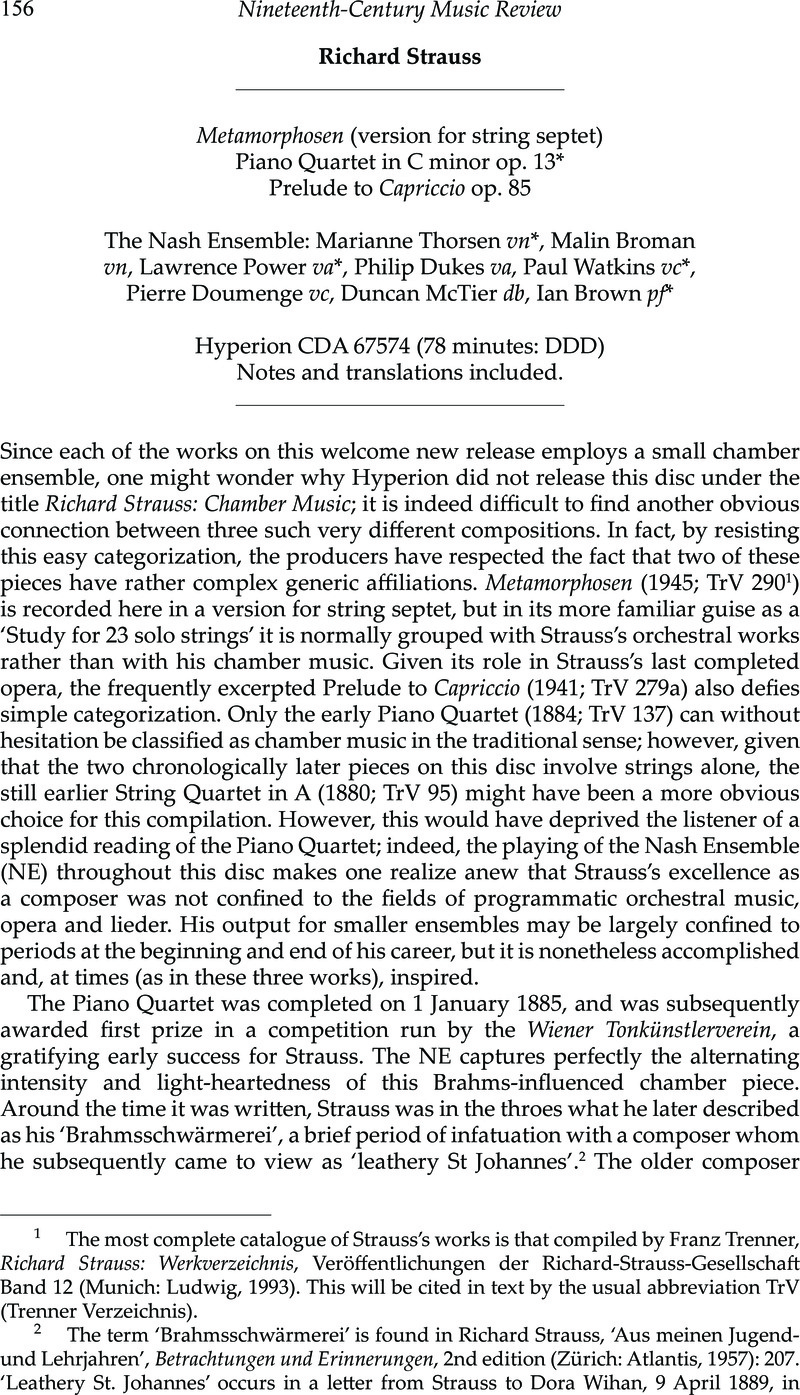No CrossRef data available.
Article contents
Richard Strauss
Published online by Cambridge University Press: 13 April 2011
Abstract

- Type
- CD Reviews
- Information
- Copyright
- Copyright © Cambridge University Press 2008
References
1 The most complete catalogue of Strauss's works is that compiled by Franz Trenner, Richard Strauss: Werkverzeichnis, Veräffentlichungen der Richard-Strauss-Gesellschaft Band 12 (Munich: Ludwig, 1993). This will be cited in text by the usual abbreviation TrV (Trenner Verzeichnis).
2 The term ‘Brahmsschwärmerei’ is found in Strauss, Richard, ‘Aus meinen Jugendund Lehrjahren’, Betrachtungen und Erinnerungen, 2nd edition (Zürich: Atlantis, 1957): 207.Google Scholar ‘Leathery St. Johannes’ occurs in a letter from Strauss to Dora Wihan, 9 April 1889, in Reviews Schuh, Willi, Richard Strauss: A Chronicle of the Early Years 1864–1898, trans. Whittall, Mary (Cambridge: Cambridge University Press, 1982): 165Google Scholar.
3 The relationship between the two works has been remarked on by Gilliam, Bryan (Richard Strauss, Cambridge: Cambridge University Press, 1999: 26), and particularly byGoogle ScholarTodd, R. Larry (‘Strauss before Liszt and Wagner: Some Observations’, in Richard Strauss: New Perspectives on the Composer and His Work, ed. Gilliam, Bryan, Durham, NC: Duke University Press, 1992: 3–40, here 5–7)Google Scholar.
4 The Particell bears the title ‘Andante (für 2 Violinen, 2 Bratsche, 2 Celli, 1 Contrabaß)’.
5 The description ‘Handgelenksübungen’ occurs in a letter Strauss wrote to his future biographer, Willi Schuh, on 8 October 1943. See Strauss, Richard, Briefwechsel mit Willi Schuh (Zürich: Atlantis, 1969): 50Google Scholar.
6 Tagebuch Blau IV, 39 and inside cover. This is held with the rest of Strauss's diaries at the Strauss Villa in Garmisch-Partenkirchen (the Strauss family archive). I would like to thank Frau Gabriele Strauss-Hotter for allowing me access to this uniquely valuable collection of primary source material. The diaries are currently being edited for publication by Jürgen May and Walter Werbeck.
7 Matthijs Vermeulen, ‘Een dubbel schandaal: Het Concertgebouw herdenkt Hitler’, De Groene Amsterdammer, 11 Oct. 1947, 7; discussed in Timothy L. Jackson, ‘ The Metamorphosis of the Metamorphosen, in Richard Strauss: New Perspectives on the Composer and His Work, ed. Gilliam, Bryan (Durham, NC: Duke University Press, 1992): 193–241, here 201–2.Google Scholar Elsewhere in his article, Jackson speculates on a connection between Metamorphosen and Goethe's nihilistic poem ‘Niemand wird sich selber kennen’. This idea has been taken up more recently by Charles Youmans, who has written briefly but insightfully on the work, situating it in terms of Strauss's lifelong devotion to Goethe and his overall intellectual/philosophical development. See Richard Strauss's Orchestral Music and the German Intellectual Tradition (Bloomington: Indiana University Press, 2005): 129–32Google Scholar.


